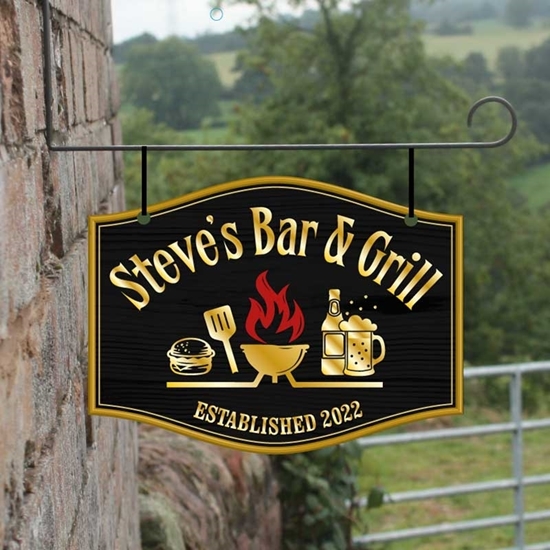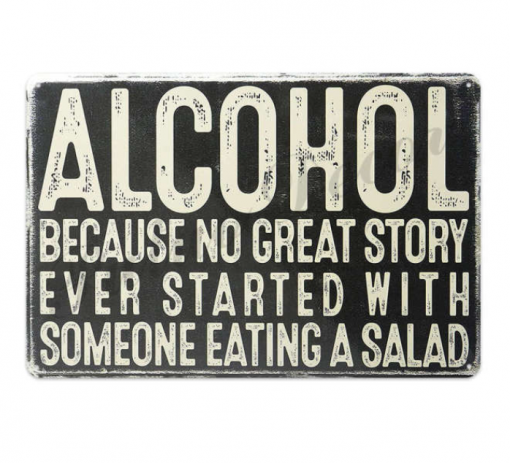Free Facts On Deciding On Personalised Pub Signs
Wiki Article
How Do Bar Signs Differ From One Another In Relation To Their Intended Purpose?
The purpose of bar signposts can be very different. Bar signs are used for many different purposes. Branding
The purpose of this campaign is to create and strengthen the brand identity of the bar.
Features: Include the bar's logo, name and the signature colors. It's designed to be an important element that reflects the overall style and theme of the bar.
For example neon signs that have a bar's logo or custom metal signs that feature the name of the bar.
2. Information
The purpose of this document is to offer vital details for patrons.
Features: Text that is easy to read and conveys important information, such as the times of operation, Wi Fi passwords, bathroom regulations or house area.
Examples: Signs near the entrance indicating hours of service or signs that indicate restrooms.
3. It is a decorative item.
Goal : To improve the appearance and atmosphere of the bar.
Special Features: They are typically more creatively themed and are a part of the overall look of the bar. It is not allowed to include text or specific details.
Examples include: old advertising for beer, funny signs or quirky artwork.
4. Promotional Items
Purpose to promote specific products or services or even events.
Features: Design with attractive graphics that showcase special offers or events coming up. It may contain temporary or re-usable elements.
For example, chalkboards with daily deals, banners advertising happy hour, or posters advertising upcoming events.
5. Directional
Use: To direct customers to the correct bar.
Specifications: Clear directions or arrows that guide customers to the right areas, like bathrooms, exits or the different bars.
The signs point out bathrooms, "Exit", arrows indicating different seating sections.
6. Regulatory/Compliance
The purpose of this document is to comply with all legal requirements as well as to ensure safety.
Features: Signs that are required to comply with legal requirements such as smoking zones, occupancy limits or emergency exits.
For example, "No Smoking", "Occupancy Limit" and "Emergency Exit" signs.
7. Interactive
Purpose to engage with customers and create engaging experiences
Features: The elements that promote patron involvement, such as surfaces that can be written on, or use digital interactions.
Signs with QR Codes linking to menus that are digital (or social media) or chalkboards for customer messaging are examples.
8. Thematic
Purpose: To create an environment or theme.
Highlights: Signs that fit the bar's theme and contribute to the overall ambience.
Examples: Pirate-themed signs in the nautical bar, rustic wooden signs in a country-themed bar.
9. Menu
Scope: To showcase the bar's menu items.
The list of food items and drinks is typically listed clearly and their costs. Can be static, or can change.
Examples include digital screens that show food items that rotate, or drinks lists that are mounted on the wall.
Each bar sign is made to fulfill a specific purpose. Its design is determined by the function it plays in the bar. When they understand the different types, bar owners will be able to select and position the signs in a way that enhances the patron's experience and also meets their needs for operation. View the most popular man cave signs recommendations for website advice including personalised pub signs, pub bar signs for sale, hanging tavern sign, the staying inn bar sign, design your own bar sign, personalised garden bar signs, personalised home pub sign, gin bar sign, hanging pub signs, bar hanging sign and more.

How Do Bar Signs Differ In Terms Of Mounting And Installation?
The kind of bar sign, its size and weight, its location, and the intended use will determine how it is mounted and installed. This article will provide a comprehensive overview of the various mounting and installing techniques for bar signs. 1. Wall-mounted signs
Specifications: Attached directly to walls.
Methods:
Anchors and screws: Common for larger signs (metal or wood) to make sure they are stable.
Adhesive Strips are able to be used for light signs (foam boards or acrylics) and temporary installations.
Brackets are a great way to display signage that extends beyond the wall.
Uses: Indoor decor, menu boards, directional signs.
Highlights: Secure, flexible and allows prominent display.
The disadvantages of this product are that It can damage the walls and is hard to position.
2. Hanging Signs
Specifications Suspended ceilings or overhangs.
Methods:
Chains: Sturdy and adjustable, ideal for heavy signs.
Cables: More slim. Most often used in modern designs.
Rods: Provide a rigid support structure.
Uses: Ceiling decor, directional signs, overhead promotional signs.
Benefits: Very visible, makes use of vertical space, and is a decorative option.
Advantages
3. Freestanding Signs
Characteristics Not attached to a structure.
Methods:
A-Frames can be folded and carried around. They are often employed to advertise on the sidewalk.
Pedestal Stands: Stable base, ideal for indoor use.
Post and Panel: Typically used for permanent, larger signs.
Uses: Outdoor advertising, indoor directional signs, promotional displays.
The lightweight and flexible design makes it easy to adjust.
It is often bulky and requires the use of a floor.
4. Window Signs
Characteristics: Attached to the window directly.
Methods:
Suction Cups: Simple to install and remove and are suitable for signs with lighter weights.
Adhesive Vinyl can be used for decals or graphics.
Static Cling is not permanent and it is reusable. It's also very easy to apply.
Uses: Promotional messaging advertising, branding, operating hours.
The window is extremely visible, and it maximizes the amount of space available.
Disadvantages: Limited by size of window, may be affected by sunlight.
5. Backlit Signs and Edge-Lit Signs
Features: Include lighting in the sign's structure.
Methods:
Wall Mounting With Electrical Connections. Requires electrical connection and secure attachment.
Suspended Power Cables The hanging method is combined with and integrated lighting.
Uses: Menu boards, branding with high visibility and decorative elements.
Benefits: Better visibility and attractive illumination.
The disadvantages are that installation requires electricity and is more complicated.
6. Temporary and portable signs
Features: Easy to install and remove.
Methods:
Pop-Up stands are lightweight and foldable.
Banner Stands: Roll-up or retractable designs.
It is used for promotions, events and seasonal decorations.
Benefits: Easy transportation and quick set up.
Advantages Less durable and less solid.
7. Magnetic Signs
Magnetic force is used to attach.
Methods:
Magnet Strips: Adhere to the back of the sign.
Magnetic Boards. Signs attached to metallic surfaces.
Uses: Menu boards that are updated, as well as notices to be used for temporary purposes.
Benefits The benefits are that no permanent fixtures are required and the item is easy to replace.
Advantages Available only on magnetic surfaces. It is less secure.
8. Projection Signs
The main features: Use light to project an image or text.
Methods:
Mounted Projectors: Securely mounted to ceilings or walls.
Portable projectors can be placed on tables or other surfaces.
Uses include: dynamic displays, events, and promotions.
Benefits The content can be modified quickly, and no physical signage is required.
Advantages
Considerations in Mounting and Installing
Weight and Size
Heavy Signs: These signs require stronger solutions for mounting, including anchors and screws.
Light Signs are produced using different methods like adhesive strips and suction cups.
Durability
Use more durable mounting methods to create permanent signs.
Temporary Signs: Choose one that permits simple removal and repositioning.
Location
Indoor: More flexible with materials, methods and weather resistance.
Outdoor: Requires weather resistant materials and secured mounting in order to withstand elements.
Aesthetics
Concealed Mounting gives the appearance of a neat design by hiding the hardware.
Decorative hardware: Enhances the look of a sign.
Accessibility
Easy access for changes Perfect for signage that must be updated frequently like menu boards.
Security: Make sure signs can't be easily manipulated or taken.
Bar owners need to consider these factors to choose the most suitable mounting and installation method that meets their requirements. This will ensure that their signage are secure, visible and satisfy their aesthetic and functional requirements. Take a look at the recommended hanging signs blog for site recommendations including personalised signs for home bar, to the bar sign, the pub sign, gin bar sign, pub signs personalised, bar signs for home, buy bar signs, personalised signs for home bar, large bar signs, large personalised bar signs and more.

What Are The Main Differences Between Bar Signs And Interactive Signs?
The interactivity of bar signs will vary in order to attract customers and enhance the customer experience. Here are a few examples of bar signs that vary in terms interactivity. Static Signs
Static signs are a traditional way to convey information. They don't have any interactive elements.
Common types include: printed posters or painted murals.
2. Digital Displays
Digital signs offer real-time updates and animations as well as multimedia content.
Touchscreen displays offer interactive content, such as promotional or games.
Benefits: Draw attention to information that is dynamic while promoting patron engagement.
3. QR Codes
QR Codes on signs The QR codes on signage can be used to provide a link to menus, promotions or social media profiles.
Benefits: Give easy access to additional information and promotions or loyalty programs.
4. LED Screens
LED screens are capable of display scrolling text or animations.
LCDs with touch-enabled touchscreens permit users to interact with their content. This includes selecting menu options, or playing games.
Benefits Include: Grab your audience's attention through creating experiences that are immersive.
5. Projection Mapping
Immersive Experiences Projection mapping transforms surface into dynamic displays, offering interactive storytelling and interactive visuals.
Interactivity: Guests can interact through interactive elements, like games or virtual experience.
Benefits: Improve the ambience and increase social interaction.
6. Augmented Reality (AR).
Enhanced Reality: AR overlays digital content onto the physical space, providing immersive experiences.
Signs with AR capabilities: AR signs allow customers to interact and view virtual elements like cocktails, or play virtual games.
Benefits: Differentiate your bar from other bars by providing distinct experiences that are engaging for patrons and creating a buzz.
7. Motion Sensors
Motion sensors sense movement to cause interactive signage to be activated.
Interactivity: Signs respond to the movement of patrons through animations, changing content, or displaying specific messages.
Benefits include: increasing engagement, creating immersive environments as well as delighting and surprising patrons.
8. Social Media Integration
Signs with social media handles, hashtags and other data can be used to promote engagement on the web.
User-Generated Media: Inspire customers to share pictures of signage through social media platforms. This can increase visibility and reach.
Benefits include a stronger sense of community, increased brand recognition and user-generated content.
9. Interactive Lighting
Interactive lighting: Signs that have neon or LED lights that respond to motion and sound, or movement.
Interactivity: Signs alter hue or brightness, or even patterns in response to patron interactions or environmental cues.
Benefits: Create immersive ambiences and enhance the ambience and draw the attention of your guests.
10. Gamification
Interactive Games: Signs that include interactive games and challenges to draw customers in and encourage them to participate.
Offer discounts and freebies in order to encourage participants to take on challenges and even win games.
Benefits include: Increasing dwell time, fostering interactions with others, and promoting return visits.
Incorporating interactive elements into their signage the bar's owners can create interactive experiences that draw patrons in and help build brand awareness and distinguish their establishment from an increasingly competitive marketplace. Follow the recommended make a pub sign for more tips including personalised garden pub sign, bar signs for garden, large bar signs, home bar pub signs, pub signs, personalised cocktail sign, pub wall sign, gin bar sign, personalised outdoor bar signs, cocktail bar sign and more.
